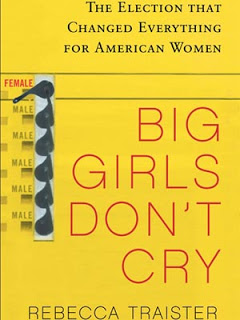 |
| Big Girls Don’t Cry: The Election that Changed Everything for American Women |
Rebecca Traister’s Big Girls Don’t Cry looks at the 2008 election through a feminist lens and, (no surprise), focuses most on primary candidate Hillary Clinton, and later Sarah Palin. The book is, however, much more than just an analysis of the sexism these two women endured. Big Girls Don’t Cry looks at the ways in which the media itself was forced to adapt, particularly to Clinton’s historic run at the presidency. This book is an excellent, smartly written look back at gender politics in 2008. For me, it reopened wounds and ignited anger I felt during the election cycle, when I heard, time and again, painful misogynist commentary coming from our so-called liberal media. However, the book provides a kind of catharsis: if we can look back through Traister’s clear eye, maybe we–individuals and the collective–will change.
looks at the 2008 election through a feminist lens and, (no surprise), focuses most on primary candidate Hillary Clinton, and later Sarah Palin. The book is, however, much more than just an analysis of the sexism these two women endured. Big Girls Don’t Cry looks at the ways in which the media itself was forced to adapt, particularly to Clinton’s historic run at the presidency. This book is an excellent, smartly written look back at gender politics in 2008. For me, it reopened wounds and ignited anger I felt during the election cycle, when I heard, time and again, painful misogynist commentary coming from our so-called liberal media. However, the book provides a kind of catharsis: if we can look back through Traister’s clear eye, maybe we–individuals and the collective–will change.
The book is especially incisive when discussing how the media–the news media and entertainment realm–itself had to change in reaction to the election, and provided several “Ah ha!” moments for me.
Here’s an excerpt from her chapter “Pop Culture Warriors.”
If Katie Couric was the nail in Sarah Palin’s vice-presidential coffin, the hammer was Tina Fey. Fey’s deadly impression of Palin was played out over half a dozen sketches for which Fey returned to Saturday Night Live, where she had been the first female head writer and where, in February, she made news with her comedic defense of Hillary Clinton, “Bitch is the new black.”
[…]Fey’s take on Palin was serendipitous, prompted by the strong resemblance between the two women. But that likeness was part of what made it groundbreaking: a vice-presidential candidate looked like a famous comedian. A female comedian. And on it went. Hillary Clinton had been played by Poehler for several years. The interview that brought Palin low had been administered by Couric, a woman also played by Poehler. The vice-presidential debate had been moderated by Gwen Ifill, prompting a guest appearance by the inimitable Queen Latifah. Inasmuch as each of the impersonations relied on the amplification of feminine traits–Poehler/Couric’s heavily mascara’d and incessant blinking, Poehler/Hillary’s hyenic laugh, Fey/Palin’s sexy librarianism–in ways that might indeed be sexist or reductive, those characteristics were ripe for amplification only because the objects of political and media parody had high-pitched laughs and wore mascara and pencil skirts. The heightened femininity of Palin’s political persona also came in for examination; during the Couric-Palin sketch, Couric pointed out to a stumped Palin, “It seems to me that when cornered you become increasingly adorable.” That little one-liner, accompanied by Fey’s inspired shooting of fake finger guns, distilled a gender dynamic–wherein women infantilize themselves as a defensive strategy–it might otherwise take thousands of words to unspool.
[…]
But in comedy, as in real life, the arrival of Palin on the scene threw Clinton into a new focus. Next to Palin, Clinton’s good qualities–her brains, competence, work ethic, her belief in secular government and reproductive freedoms, her ability to complete sentences–became far more evident than they had been before there was another potential “first woman” to compare her to. Nothing conveyed these haze-clearing realignments of perspective as quickly and as firmly as Fey and Poehler did in five and a half minutes. The parodic depiction of the two women side by side exposed the complex dynamics of Palin’s parasitism, their unwilling symbiosis, and their stark differences.
You can read reviews of the book at Gender Focus and Feministing.
